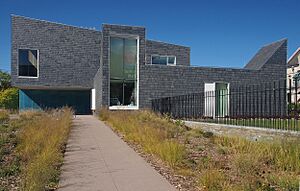American Swedish Institute facts for kids

The main buildings of the American Swedish Institute
|
|
| Lua error in Module:Location_map at line 420: attempt to index field 'wikibase' (a nil value). | |
| Former name | American Institute for Swedish Arts, Literature and Science |
|---|---|
| Established | 1929 |
| Location | 2600 Park Avenue, Minneapolis, Minnesota |
The American Swedish Institute (ASI) is a museum and cultural center in Minneapolis, Minnesota. It helps people learn about the history and culture of Sweden and Swedish Americans in the United States. The museum has two main parts: the Swan Turnblad Mansion, which was finished in 1908, and the Nelson Cultural Center, which opened in 2012.
Today, ASI is a place where everyone can come together. They share experiences about culture, how people move from one country to another, the environment, and art. The museum often has special art shows from Sweden and other Nordic countries. They also have fun programs for kids and families. Their restaurant, FIKA, is famous for its New Nordic food.
Contents
History of the Institute
The American Swedish Institute is located in a beautiful old mansion. This house was built for a Swedish immigrant couple, Swan and Christina Turnblad.
Swan Turnblad's Journey
Swan Turnblad came to the United States with his family in 1868 when he was eight years old. His parents left their farm in Småland, Sweden, because there wasn't enough food. The family settled in a Swedish community in southern Minnesota called Vasa.
Swan didn't want to be a farmer like his parents. In 1879, he moved to Minneapolis. There, he started from nothing and became very successful. Swan first worked as a typesetter for Swedish newspapers. He became very interested in printing. This led him to become the owner of a Swedish newspaper called Svenska Amerikanska Posten.
Under Swan's leadership, the newspaper became very popular. Its weekly circulation grew from 1,400 to over 40,000 copies! This newspaper was probably the main source of Swan's wealth. He used the best printing machines available. His paper was the first Swedish one in America to use a Linotype machine. In 1903, it was also the first Swedish paper to use a special color printing press. This allowed them to print colorful pictures.
Christina Turnblad's Story
In Minneapolis, Swan met and married Christina Nilsson. She also came to America from Sweden with her family. Her family settled in Worthington, Minnesota, in 1876 when Christina was 15. Her first job in America helped her learn English. Later, she worked as a waitress. In 1882, Christina moved to Minneapolis. She met Swan at a meeting for a group called the Good Templars. They got married in 1883, and their only child, Lillian Zenobia, was born a year later.
Building the Mansion
In the early 1900s, the Turnblads started planning their grand home. They had traveled to Europe many times. These trips likely inspired the mansion's castle-like style and fancy inside designs. They bought the land on Park Avenue in 1903. The Minneapolis architects Christopher A. Boehme and Victor Cordella drew up the plans.
The house took almost five years to build. The Turnblads paid for everything as they went, so they didn't need a loan. There are no records of how much it cost. But when the museum opened in 1929, the Minneapolis Tribune newspaper said it was believed to have cost close to $1 million.
From Home to Museum
The mansion became a museum in 1929. The family gave the house and the newspaper to start the American Institute for Swedish Arts, Literature and Science. This name was later changed to the American Swedish Institute. Swan Turnblad said he had always planned for the house to be a Swedish-American center. He once said, "many persons may have wondered what a small family like ours... wanted with so big a house. Perhaps they can guess now."
The mansion is now on the National Register of Historic Places. This means it's a special building because of its architecture, art, and educational history. In 1995, the second floor of the mansion was repaired. Damaged plaster and gold decorations were fixed. This work even won an award!
In 2012, ASI opened a new building called the Nelson Cultural Center. It is about 34,000 square feet. This new part has more space for art shows, craft workshops, a glass-enclosed entrance, a gift shop, and the FIKA restaurant. It also has rooms for concerts, talks, and community events. The King and Queen of Sweden, King Carl XVI Gustaf and Queen Silvia, came to dedicate the new building.
Exhibits at ASI
The American Swedish Institute often has interesting exhibits. Here are some examples of past shows:
- The Watercolor Worlds of Lars Lerin – This show featured art by Lars Lerin, a Nordic artist. His work is known for being both dreamy and very detailed.
- Nordic: A Photographic Essay of Landscapes, Food and People – This exhibit showed photos by Magnus Nilsson, a famous chef.
- Eight Seasons in Sápmi, the Land of the Sámi People – This exhibit explored the art and culture of the Sami people. They live in the northern parts of Sweden, Norway, Finland, and Russia.
- Papercut! The Incredible Psaligraphy of Karen Bit Vejle – This show displayed 54 amazing paper creations.
- Nobel Creations – This exhibit featured special clothing designs from students at Beckmans College of Design. These designs were on loan from the Nobel Museum in Stockholm, Sweden.
Annual Christmas Exhibit
Since the 1950s, ASI has had special Christmas displays. They show how Christmas is celebrated in different Scandinavian countries. Each year, a room in the mansion is decorated to represent a different country. These include Sweden, Norway, Finland, Iceland, and Denmark. Sometimes, they even add a "guest country" to the display. For example, in 2014, they had a Navidad room from Mexico, and in 2015, a Russian Christmas room.
See also


